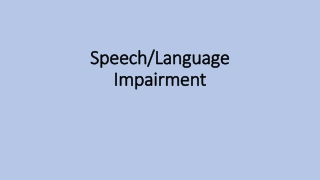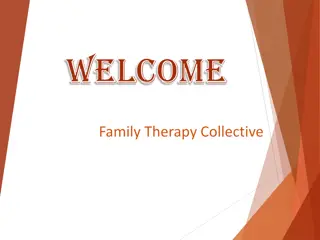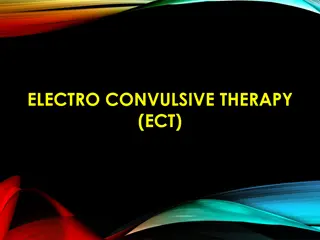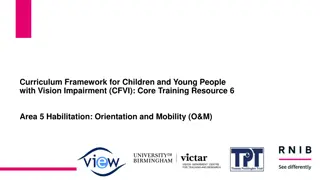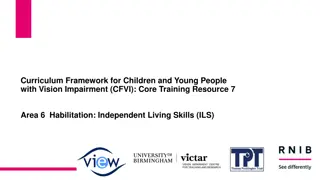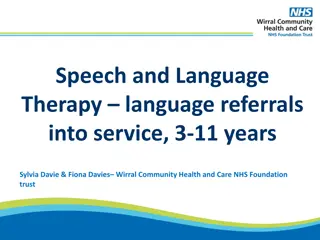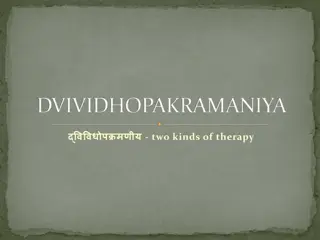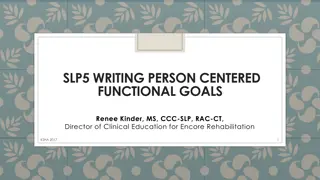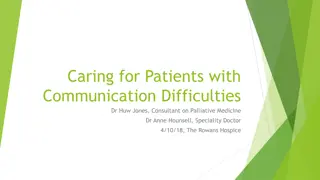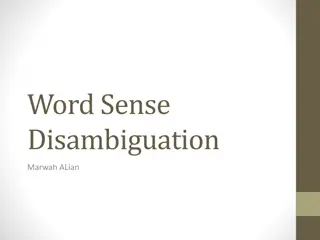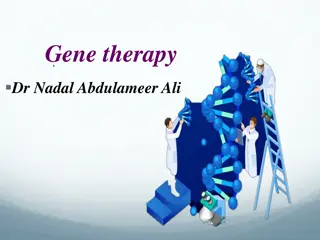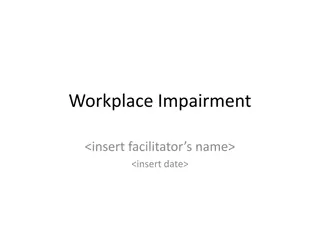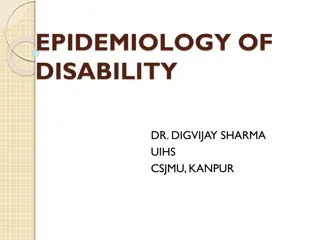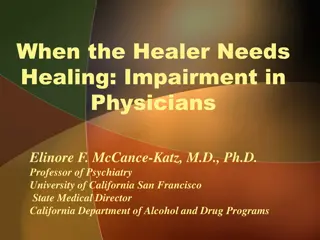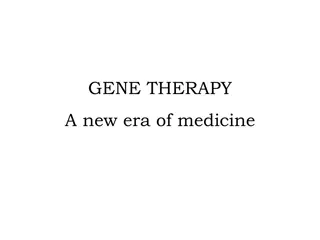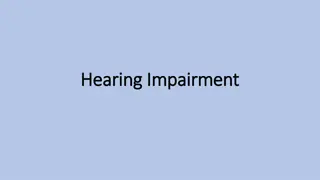Therapy Approaches for Specific Language Impairment
This content discusses therapy approaches for children with Specific Language Impairment (SLI) focusing on the effectiveness of Milieu Treatment (MT) and Recasting interventions. MT aims to improve language use in natural exchanges, while Recasting involves immediate correction or expansion of a child's utterance. Key considerations include treatment intensity and defining therapy techniques for optimal outcomes in children with SLI.
Download Presentation

Please find below an Image/Link to download the presentation.
The content on the website is provided AS IS for your information and personal use only. It may not be sold, licensed, or shared on other websites without obtaining consent from the author.If you encounter any issues during the download, it is possible that the publisher has removed the file from their server.
You are allowed to download the files provided on this website for personal or commercial use, subject to the condition that they are used lawfully. All files are the property of their respective owners.
The content on the website is provided AS IS for your information and personal use only. It may not be sold, licensed, or shared on other websites without obtaining consent from the author.
E N D
Presentation Transcript
Specific Language Impairment: Therapy approaches for children with an MLU <2 Paediatric Language Group
Paediatric Language Group: Recap Last year we looked at impact of dosage/intensity of treatment on outcomes: What was the optimum dosage/intensity for treatment in SLI? Outcomes: Distributed practice is more effective than massed practice Difficult to define how much treatment is needed (optimal intensity) Active ingredients not clearly enough defined in the literature - ie language therapists tend to use a mixture of dosage forms (eg. Modelling, recasting etc) We need to clearly define what therapy techniques we are using (dosage forms) before looking at intensity
Question for this year was: In children with Specific Language Impairment with an MLU < 2, what therapy approaches are effective?
1) For children with an MLU < 2, is Mileu Treatment an effective intervention approach? 2) For children with an MLU <2, is recasting an effective intervention approach?
Definitions Mileu Treatment (MT) focuses on improving the functional use of language in natural communicative exchanges It incorporates: - arranging the environment - Mileu teaching (elicitive models, requesting imitation, prompting questions, time delay prompts) - Functional reinforcement from the adult Target population: MLU 1.0-3.5, able to imitate, use at least 10 words
Definitions Recasting- Following a child s utterance the clinician provides an immediate expansion or correction of the child s utterance - the recast maintains the meaning of the utterance but corrects the grammatical or syntactical errors -provided in a conversational context -No child response is required - Child needs to be intelligible i.e. so the adult can provide the correct recast - Speech or language goal that is developmentally appropriate Target Population: prelinguistic preschool language
Current Question - Literature Search Nelson & Camarata (1996) Effects of imitative and conversational recasting treatment on the acquisition of grammar in children with specific language impairment and younger language-normal children. Journal of Speech & Hearing Research, 39, 4, 850-860. Yoder, Molfese & Gardner (2011). Initial mean length of utterance predicts the relative efficacy of two grammatical treatments in preschoolers with specific language impairment. Journal of Speech, Language, and Hearing Research, 54, 1170-1181. Camarata, Yoder & Camarata (2006) Simultaneous treatment of grammatical and speech-comprehensibility deficits in children with Down Syndrome. Down Syndrome Research and Practice, 11 (1), 9-17. Trent-Stainbrook, A., Kaiser, A. & Frey, J (2007). Older siblings use of responsive interaction strategies and effects on their younger siblings with Down Syndrome. Journal of Early Intervention, 29, 4, 273-286.
Current Question - Literature Search Kaiser, A., Dickinson, D., Roberts, M., Darrow, C., Freiberg, J., Hofer, K. (2011). The Effects of Two Language-Focused Preschool Curricula on Children s Achievement through First Grade. SREE Conference Abstract Template. Hassink, J. & Leonard, L. (2010). Within-Treatment Factors as Predictors of Outcomes Following Conversational Recasting. American Journal of Speech- Language Pathology, 19, 213-224. Yoder, P., Camarata, S. & Gardner, E. (2005). Treatment Effects on Speech Intelligibility and Length of Utterance in Children with Specific Language and Intelligibility Impairments. Journal of Early Intervention, 28 (1), 34-49 DesJardin, J. & Eisenberg, L. (2007). Maternal Contributions: Supporting Language Development in Young Children with Cochlear Implants. Ear & Hearing, 28, 456-469.
Current Question- 3 Key articles Yoder P, Kaiser A, Goldstein H, Alpert C, Mousetis L & Fisher R (1995). An Exploratory Comparison of Milleu Teaching and Responsive Interaction in Classroom Applications. Journal of Early Intervention, 19(3), 218-242. 1) 36 children in 6 different classrooms. Range of severities in language and cognitive ability. Aged between 2-7 years. Most children functioned at a 1-4 year old level 2 subgroups were formed by matching pairs of children based on ability. 4 developmentally appropriate language goals were chosen for each pair 1 group received Mileu and the other Responsive Interaction MT: models, requests for imitation, mands (open questions, choice questions), time delay prompts RI: target specific recasting, self talk, parallel talk, following the child s lead
Yoder P, Kaiser A, Goldstein H, Alpert C, Mousetis L & Fisher R (1995). An Exploratory Comparison of Milleu Teaching and Responsive Interaction in Classroom Applications. Journal of Early Intervention, 19(3), 218-242. Teachers trained in the techniques implemented either mileu or responsive interaction to their class Therapy given 4-5 days a week, 15-30 mins, for 64 days. At least 3 activities per day conducted in free play, mealtimes, circle and small group Results Both mileu and responsive interaction effective at increasing child s outcomes For children with low expressive or receptive (age equivalent under 22-26 months) milleu more effective than responsive interaction. Thought that elicited teaching more effective at teaching early targets (vocabulary learning and semantic relationships) Higher language (age equivalent above 33-45 months) responsive interaction was more effective
Article 2) Nelson & Camarata (1996) Effects of imitative and conversational recasting treatment on the acquisition of grammar in children with specific language impairment and younger language-normal children. Journal of Speech & Hearing Research, 39, 4, 850-860. Compared imitative treatment with conversational recasting 7 Children with SLI (ages 4.7-6.7 years) matched with 7 language normal children (ages 2.2-4.2 years) 6 grammatical targets selected for each child (3 absent, 3 partially absent). Included a range: Eg. Aux, articles, possessives, relative clauses, passives, complex questions Targets randomly allocated to a control condition (no intervention), imitation or recast condition
Nelson & Camarata (1996) Effects of imitative and conversational recasting treatment on the acquisition of grammar in children with specific language impairment and younger language-normal children. Journal of Speech & Hearing Research, 39, 4, 850-860. Received sessions 2x wk, avg 18 sessions in total. In every session, each child received: -no intervention for 2 targets -imitation intervention for 2 targets eg. For the auxiliary: Prompt: Child shown appropriate picture Clinician Model: The boy is running Request for imitation: Say the boy is running -recasting intervention for 2 targets eg. For regular past tense: Child: The baby talk Adult recast: Yes, the baby talked on the phone
Nelson & Camarata (1996) Effects of imitative and conversational recasting treatment on the acquisition of grammar in children with specific language impairment and younger language-normal children. Journal of Speech & Hearing Research, 39, 4, 850-860. Results: Found that children with SLI and normal language acquire language targets faster when conversational recasting treatment is used compared with imitative or no treatment. Found that SLI children and their matched normal language children were similar in the grammatical progress Suggested that SLI children can sometimes learn grammatical structures as efficiently as WNL language children if language is tailored to specific language levels. Frequency issue?
Article 3) Yoder, Molfese, Gardner (2011). Initial Mean Length of Utterance Predicts the Relative Efficacy of Two Grammatical Treatments in Preschoolers with Specific Language Impairment. Journal of Speech, Language, and Hearing Research, 54, 1170-1181. Determine whether MLU at pretreatment could predict which 2 language treatments were more effective (MT vs Broad Target Recasting) 57 Preschoolers with SLI, avg MLU 1.0-3.5, at least 10 different words Randomized to a MT group or a Broad Target Recast (BTR) group MT group: 3 targets selected for each child. Child directed play activities. A series of prompts were used to elicit the target (models, questions, requests for imitation). Feedback provided BTR group: child directed play activities. No specific targets selected Received 30 mins therapy, 3x wk for 6 months
Yoder, Molfese, Gardner (2011). Initial Mean Length of Utterance Predicts the Relative Efficacy of Two Grammatical Treatments in Preschoolers with Specific Language Impairment. Journal of Speech, Language, and Hearing Research, 54, 1170-1181. Results: -Children with pre-treatment MLU <1.84 : MT facilitated a growth in grammar faster than BTR -Children with a pre-treatment MLU > 1.84: No significant difference between MT and BTR -Treatment effects were maintained 5 months post-treatment
Other interesting findings. Other populations may benefit from recasting techniques: 6 Children with Down Syndrome who received 2x wk recasting therapy over 6 months showed improvements in speech comprehensibility (overall intelligibility) and MLU (Camarata, S et al 2006) Children with cochlear implants: Frequency of the mother s recasts was positively associated with receptive language skills, MLU, number of words and different word types (Des Jardin et al 2007) Recasting may be effectively implemented by people other than speech pathologists, although there are mixed results from these studies - Older siblings of children with Down Syndrome can be trained to use responsiveness interaction strategies (which includes recasting techniques). Success in some participants with increasing the frequency of social commenting (Trent-Stainbrook et al, 2007) - Large number of studies have looked at effectiveness of training parents and teachers
Other interesting findings. The frequency/rate of recasting is important- Children with SLI need to be exposed to a high rate of recasts in comparison to typically developing children. (Proctor, Williams, Fey, 2001) -need to consider frequency of recasts -need to consider giving parents specific goals re frequency Different variables within the recasting process can influence the effectiveness of recasting (Hassink et al 2010) -recasts are more effective if the child s utterance contains a subject eg. Child: man drinking Adult: The man is drinking More effective than Child: drinking Adult: The man is drinking Recasting subject-less utterances may place additional processing on the child and be less effective
Other interesting findings. Recasts don t always have to occur following an utterance where the child makes an error on the target. Eg. Target: 3rd person singular Child: That guy drinking again Adult: He drinks his milk everyday Recasts don t always have to follow a child utterance. The adult can self-recast following their own utterance Eg. Adult: It s a cow Child: No response Adult: It s a cow drinking
E3BP Clinicians in language group tested out techniques used during single activity/goal. Goal: he/she acquisition Clinicians in the group each recorded a session and were found to use a mix of the following techniques recasting, sentence completion, phonemic cueing, imitation and modeling Also trialled a session in which they solely used recasting. Found it very difficult to only use recasting especially with children who had more severe language skills or had no mastery of the target (as clinician had to self-recast the whole activity) Found that we tended to use recasting with children with higher language levels as self-recasting only feels unnatural What did we learn? We are using an eclectic mix of techniques good to be more aware that recasting will be more effective with children with a MLU < 2. Clinicians in group now have a better understanding of what Milleu teaching is and how to use it in practice/appropriate candidates for the technique.
Clinical bottom line MT and recasting are both effective therapy techniques for children with SLI and MLU<2 However Lower level children may benefit more from MT MLU <1.84 and/or Language ability lower than 22-26 months Higher level children may benefit more from recasting MLU >1.84 and/or Language ability above 33-45 months
Clinical Bottom Line Why is MT potentially more effective for lower level children? Production practice may be more effective than listening to models alone (Connell, 1987; Ezell & Goldstein, 1989) Recasting may be more difficult to do with lower level children because: They talk less frequently The child s intended message may not always be clear Why is recasting potentially more effective for higher level children? More complex syntax may be difficult to teach using MT Children with more advanced language provide more frequent utterances for the adult to recast on
In Summary Things to consider: Child s MLU Choosing specific targets during recasting Adequate rate/intensity of recasts or MT episodes The types of recasts provided eg. Avoiding recasting too much information, avoiding recasting on utterances where the intended message is not clear
Thank you for listening See you next year!!!
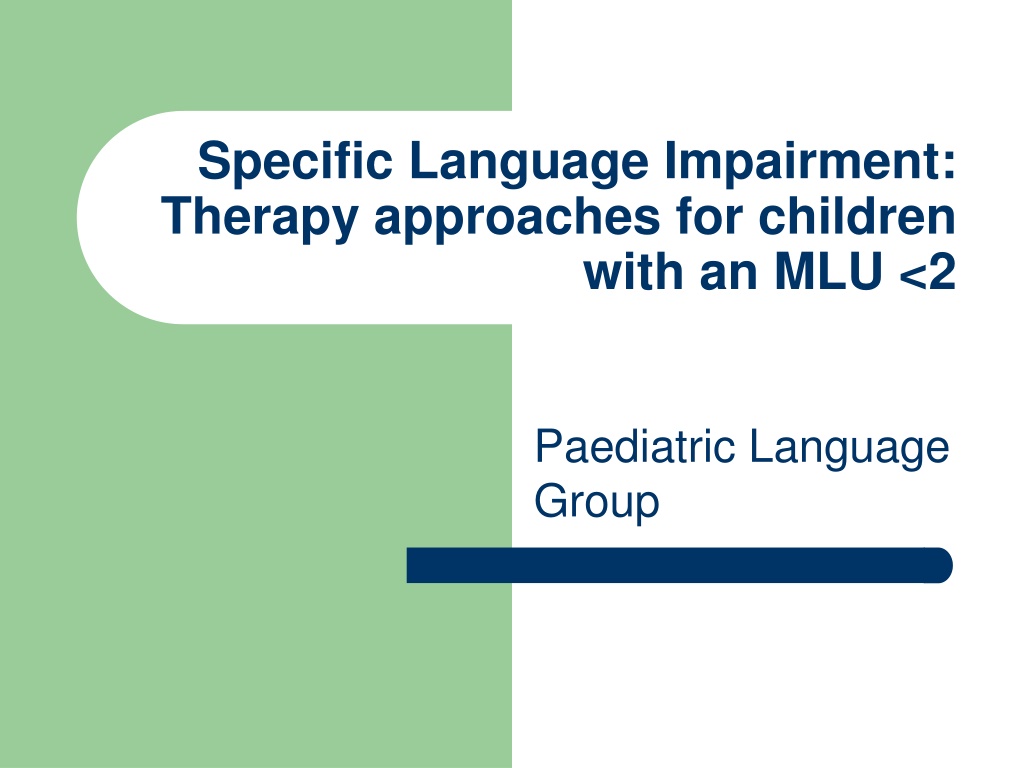
 undefined
undefined




